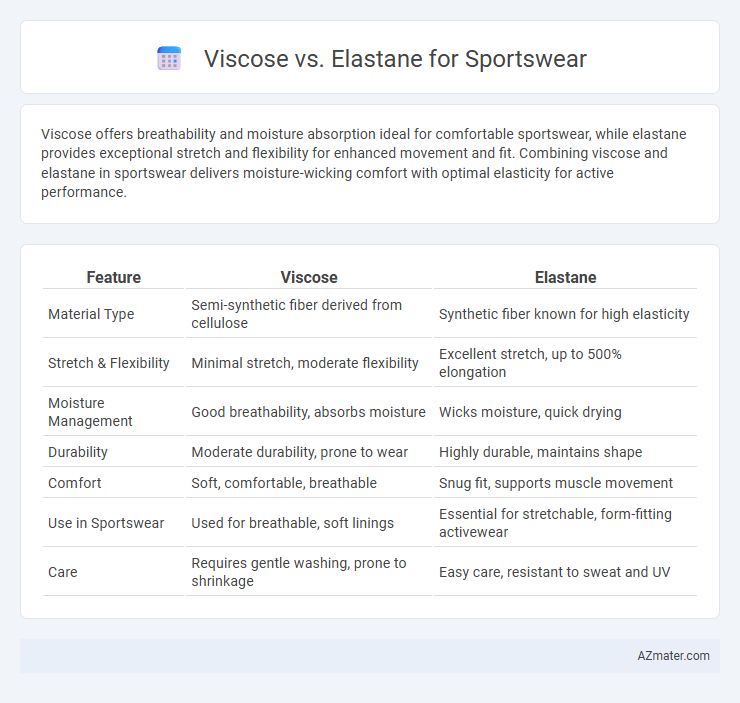Viscose offers breathability and moisture absorption ideal for comfortable sportswear, while elastane provides exceptional stretch and flexibility for enhanced movement and fit. Combining viscose and elastane in sportswear delivers moisture-wicking comfort with optimal elasticity for active performance.
Table of Comparison
| Feature | Viscose | Elastane |
|---|---|---|
| Material Type | Semi-synthetic fiber derived from cellulose | Synthetic fiber known for high elasticity |
| Stretch & Flexibility | Minimal stretch, moderate flexibility | Excellent stretch, up to 500% elongation |
| Moisture Management | Good breathability, absorbs moisture | Wicks moisture, quick drying |
| Durability | Moderate durability, prone to wear | Highly durable, maintains shape |
| Comfort | Soft, comfortable, breathable | Snug fit, supports muscle movement |
| Use in Sportswear | Used for breathable, soft linings | Essential for stretchable, form-fitting activewear |
| Care | Requires gentle washing, prone to shrinkage | Easy care, resistant to sweat and UV |
Understanding Viscose: Key Properties
Viscose offers excellent breathability and moisture absorption, making it suitable for sportswear that requires comfort and temperature regulation. Its soft texture provides a lightweight feel against the skin, enhancing wearability during physical activities. However, viscose lacks natural elasticity, so it is often blended with elastane to improve stretch and flexibility in activewear.
What is Elastane? Composition and Benefits
Elastane, also known as spandex or Lycra, is a synthetic fiber composed primarily of long-chain polyurethane segments, prized for its exceptional elasticity and stretch recovery. It is commonly blended with other fibers such as polyester, nylon, or cotton to enhance sportswear flexibility, comfort, and fit without sacrificing durability. Key benefits include superior shape retention, moisture wicking properties, and freedom of movement, making elastane ideal for high-performance athletic apparel.
Comfort and Fit: Viscose vs Elastane
Viscose provides a soft, breathable fabric that enhances comfort during low-impact activities, offering a natural feel against the skin. Elastane delivers superior stretch and recovery, ensuring a snug fit that moves with the body for high-performance sportswear. Combining viscose with elastane creates garments that balance comfort, moisture management, and a flexible fit ideal for dynamic movements.
Moisture Management in Sportswear Fabrics
Viscose offers moderate moisture absorption but lacks quick-drying properties, making it less ideal for intense sportswear applications. Elastane enhances fabric stretch and fit but provides minimal moisture-wicking capabilities on its own. Combining viscose with elastane in sportswear fabrics balances comfort and flexibility, though additional moisture management technologies are often needed for optimal sweat control.
Breathability: Which Fabric Performs Better?
Viscose offers moderate breathability by allowing air circulation and moisture absorption, making it suitable for light to moderate physical activities. Elastane, known for its exceptional stretch and shape retention, has limited breathability since it is typically blended with other fibers to enhance performance. For sportswear prioritizing breathability, viscose or blends with higher viscose content generally perform better in managing sweat and maintaining comfort during intense workouts.
Durability and Longevity Comparison
Viscose offers a soft, breathable texture ideal for comfort but tends to wear out faster under intense physical activity due to lower abrasion resistance. Elastane, known for its exceptional stretch and recovery properties, enhances sportswear durability by maintaining shape and resisting wear through repeated movements. Combining elastane with viscose results in sportswear that balances comfort with long-lasting performance, optimizing both durability and longevity during rigorous use.
Stretch and Flexibility: Active Movement Support
Elastane offers superior stretch and flexibility, enabling sportswear to provide excellent active movement support with up to 500% elongation and quick recovery to original shape. Viscose, while breathable and soft, has limited elasticity and may restrict dynamic motion during intense physical activities. Combining elastane with viscose enhances comfort and flexibility, making the fabric ideal for sportswear that demands both freedom of movement and moisture management.
Sustainability and Environmental Impact
Viscose, derived from cellulose fibers, is biodegradable and renewable but involves chemically intensive production that can cause water pollution if not managed properly. Elastane, a synthetic fiber made from petrochemicals, is non-biodegradable and contributes to microplastic pollution during washing, raising concerns over its environmental footprint in sportswear. Sustainable options prefer viscose blends sourced from responsibly managed forests and chemical recycling techniques, while minimizing elastane content reduces long-term ecological impact.
Maintenance and Care Requirements
Viscose sportswear requires gentle washing in cold water and air drying to prevent shrinking and fiber damage, while elastane garments demand careful handling to maintain elasticity, avoiding high heat and harsh detergents. Both fabrics benefit from avoiding bleach and fabric softeners to preserve fabric integrity and stretch. Proper care extends the longevity and performance of sportswear, ensuring consistent comfort and fit during physical activities.
Best Use Cases: Choosing the Right Fabric for Sportswear
Viscose offers breathability and moisture-wicking properties, making it ideal for low-impact sports and yoga where comfort and ventilation are priorities. Elastane provides superior stretch and shape retention, perfect for high-intensity workouts, running, and activities requiring flexibility and freedom of movement. Combining viscose with elastane blends maximizes comfort, durability, and elasticity, enhancing performance across various sportswear applications.

Infographic: Viscose vs Elastane for Sportswear
 azmater.com
azmater.com